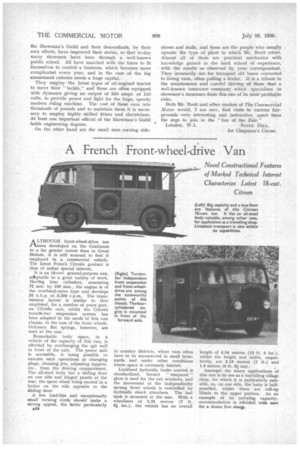A French Front-wheel-drive Van
Page 44

If you've noticed an error in this article please click here to report it so we can fix it.
Novel Constructional Features of Marked Technical Interest Characterize Latest 18-cwt. Citroen
ALTHOUGH front-wheel-drive has been developed on the Continent to a far greater extent than in Great Britain, it is still unusual to find it employed in a commercial vehicle. The latest French Citroen product is thus of rather special interest.
It is an 18-cwt. general-purpose van, adaptable to a great variety of work. Having four cylinders, measuring 72 mm. by 100 mm., the engine is of the overhead-valve type and develops 35 b.h.p. at 3,200 r.p.m. The transmission layout is similar to that employed, for a number of years past, on Citroen cars, whilst the Citroen torsidn-bar suspension system has been adapted to the needs of this van chassis, in the ease of the front wheels. Ordinary flat springs, however, are used at the rear.
Remarkable body space, in a vehicle of the capacity of this van, is afforded by overhanging the cab well in front of the axle. The power unit is accessible, it being possible so execute such operations as changing plugs, cleaning jets, adjusting tappets, etc., from the driving compartment. The all-steel body has a sliding door on one side and hinged panels at the rear, the spare wheel being carried in a locker on the side opposite to the sliding door.
A low load-line and exceptionally small turning circle should make a strong appeal, the latter particularly
,a34
in country districts, where vans often have to be manoeuvred in small farmyards and under other conditions where space is extremely limited.
Lockheed hydraulic brake control is standardized, Secant " tempered " glass is used for the cab windows, and the movement of the independently sprung front wheels is controlled by hydraulic shock absorbers. The fuel tank is mounted at the rear. With a wheelbase of 2.35 metres (7 ft. 81 ins.), the vehicle has an overall
length of 4.04 metres (13 ft. 3 ins.), whilst the height and width, respectively, are 2.13 metres (7 ft.) and
1.9 metres (6 ft. Si ins).
Amongst the many applications of
this van is its use as a travelling village shop, for which it is particularly suitable, as, on one side, the body is halfpanelled, whilst there are roll-up blinds to the upper portion. As an example of its carrying capacity, accommodation is afforded with ease for a dozen live sheep.












































































